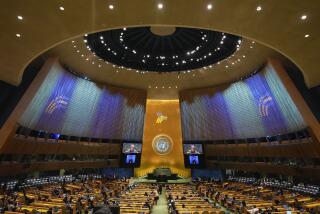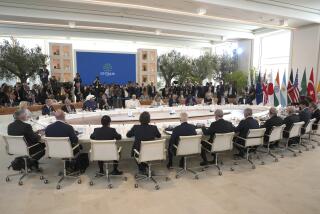Reagan, Gorbachev Wind Up Summit, See New A-Arms Cuts : No Gains on Rights Issue,Afghanistan
- Share via
WASHINGTON — President Reagan and Soviet leader Mikhail S. Gorbachev, concluding their historic third summit meeting, announced significant progress Thursday toward a treaty to slash in half the superpowers’ awesome arsenals of long-range nuclear weapons.
They claimed no breakthroughs on human rights, Afghanistan and other regional trouble spots. But they insisted that their time spent together--5 1/2 hours in business meetings and eight more hours in social occasions--would advance the cause of world peace.
Reagan, in a nationally televised speech that began just as Gorbachev lifted off from Andrews Air Force Base in his Ilyushin jetliner, said, “We have put Soviet-American relations on a far more candid, and far more realistic, footing.”
Earlier Gorbachev, during a lengthy, rambling press conference at the Soviet Embassy compound, asserted, “I would even venture to say we trust each other more.”
The President said he and Gorbachev agreed to meet again in Moscow in several months “to continue what we have achieved in these past three days. I believe there is reason for both hope and optimism.”
U.S. officials said they expect the next summit in May or June.
Gorbachev, speaking mostly from notes to 350 invited journalists, said he hoped that the two men could use that occasion to sign a treaty reducing long-range, or strategic, nuclear weapons. U.S. officials said the treaty signing, however, was not a condition for the summit, which would be the fourth between the President and the general secretary of the Soviet Communist Party.
‘Significant’ Concessions
Reagan said he and Gorbachev made “real progress” toward the goal set during their first summit in Geneva in 1985: “to achieve deep, 50% cuts in our arsenals of those powerful weapons.” And a senior Administration official said the Soviets made a “significant” concession on missile defenses.
A joint statement issued by the two sides at the end of the three-day meeting outlined three major areas of agreement on the road to reducing long-range offensive weapons--land-based intercontinental ballistic missiles (ICBMs), submarine-launched ballistic missiles and bombers carrying cruise missiles:
-- A limit on each side’s combined ICBMs and submarine-based ballistic missiles of 4,900. The two sides had already agreed that the three categories of weapons--including bombers--would be reduced to 6,000. The sub-limit, a compromise between the U.S. goal of 4,800 and the Soviet position of 5,100, reflected the U.S. effort to restrain the Soviets’ large force of heavy missiles.
-- In the area of verifying compliance with the treaty, agreement to establish procedures that build upon those of the accord signed by Reagan and Gorbachev on Tuesday to eliminate medium-range missiles. Those procedures, the most intrusive ever accepted by the Soviets, allow inspectors from each side to be stationed permanently on the other’s soil.
-- Limited agreement on the technically complicated question of how each side’s long-range nuclear weapons would be counted.
At the same time, however, a senior Administration official who asked not to be identified conceded that “there are some very thorny issues remaining” on the questions of verification and counting. And the United States could not persuade the Soviets to agree to a sub-limit on the two sides’ ICBMs, the weapon upon which the Soviets rely most heavily.
Gains on Defensive Weapons
Progress on defensive weapons--chiefly Reagan’s space-based Strategic Defense Initiative, popularly known as “Star Wars”--was no less significant, according to Administration officials. There were these accords:
-- The two leaders instructed their arms negotiators to reformulate the 1972 Anti-Ballistic Missile Treaty so that its provisions would extend for an unspecific period--up to seven years as sought by the United States and 10 in the Soviet position. The Soviets withdrew their insistence that they would not sign a treaty limiting offensive weapons without an agreement restricting SDI.
-- During the seven to 10 years, according to the joint statement, the two sides could conduct “research, development and testing” of space-based defensive systems “as required.” Previously the Soviets had insisted that the ABM Treaty prohibited testing in space.
-- After the seven to 10 years, each side would be free to deploy space-based defenses unless both had already agreed that deployment would be prohibited. Previously the Soviets had sought to keep the non-deployment period in force indefinitely.
“Nothing that was done today,” he said a senior Administration who asked not to be identified, “restrains U.S. or Soviet research, testing or development.”
Surprising Progress
Even before Reagan and Gorbachev wound up their final working session, Kenneth L. Adelman, outgoing director of the U.S. Arms Control and Disarmament Agency, expressed surprise at the degree of progress.
“They made more progress than I ever expected in terms of sub-limits and verification and some other issues,” said Adelman, a hard-liner in dealing with the Soviets. “And it was significant they could make that much progress without our compromising our position on SDI at all.”
Despite the advances, Adelman said, it would still be “very, very tough” to reach agreement on a treaty dealing with START, as the issue of strategic arms reduction is known, in time for the Moscow summit in the first half of 1988.
Gorbachev, in a 73-minute opening statement at his press conference, revealed that he and Reagan resolved some issues obstacles to a treaty slashing long-range nonly during the final minutes of their last working session, even as participants in the official farewell ceremony had already assembled on the South Lawn of the White House.
“We achieved significant, and I use that word because it is the correct word--I’ve given careful thought to this--we have achieved considerable headway on this problem, which is the major one for the Soviet Union, the United States and for other nations,” he said.
‘Good Set of Instructions’
A senior Administration official, who cut off his briefing of reporters just as Gorbachev’s press conference began, told reporters, “We succeeded in providing a good set of instructions to the delegations in Geneva.”
He said the U.S. side hopes for “the earliest possible date for the conclusion of the START treaty, preferably in time for” the next Reagan-Gorbachev summit.
Both leaders said the Washington summit would be remembered most for the treaty the two leaders signed Tuesday banning the ground-launched medium-range nuclear missiles that both sides have deployed or have in storage, mostly in Europe.
“During these three days,” Reagan said, “we took a step--only a first step, but still a critical one--towards building a more durable peace; indeed, a step that may be the most important taken since World War II to slow down the arms build-up.”
The visit, which began Monday afternoon, was Gorbachev’s first to the United States and the first visit by a Soviet leader to this country since 1973. The 56-year-old Gorbachev, in a whirlwind of activities, won wide praise from members of Congress, business executives and others with whom he met at the Soviet Embassy. And at one point on Thursday he hopped out of his armored Soviet Zil limousine at a busy intersection in downtown Washington to shake hands with lunch-hour pedestrians.
Disputes Unresolved
For all the good will and congeniality, however, Reagan and Gorbachev did not put all their disputes behind them.
In the joint statement, the United States and the Soviet Union said the summit reflected “the continuing differences between the two sides, and their understanding that these differences are not insurmountable obstacles to progress.”
Apart from arms control, Reagan insisted that the just-concluded summit dealt with “fundamental problems such as Soviet expansionism and human rights violations, as well as our own moral opposition to the ideology that justifies such practices.”
Gorbachev, in a departure statement at the White House, described the discussions of these issues as “a useful exchange of views. . . . On some of these aspects, it seems likely that we can soon identify specific solutions, satisfactory both to us and to other countries.”
No Afghan Timetable
Although Reagan had pressed his Soviet counterpart to set a timetable for pulling the estimated 115,000 Soviet troops out of Afghanistan, Gorbachev offered little new on this issue. At his press conference, he reiterated his desire to end the eight-year occupation with a political settlement “which would make it possible to put an end to the internal bloody conflict and to prevent the possibility of its recurrence.”
The joint statement also had little to say about human rights. On the day before Gorbachev’s arrival in Washington, about 200,000 people demonstrated in Washington to demand that the Soviets allow free emigration of Jews and other Soviet citizens who seek to leave the country.
Although Reagan mentioned the “resolution of a number of individual cases in which prisoners will be released or exit visas granted,” he conceded in his televised speech that there was only “some very limited movement” on the issue of human rights in general.
The two leaders, after a morning business session and a working lunch, said their farewells in an early-afternoon ceremony on the White House South Lawn that began in drizzle and ended in a steady downpour.
Both men, wearing topcoats with scarfs and standing under large black umbrellas, were tight-lipped and at times almost stony-faced--a marked contrast to the smiling countenances they frequently displayed during most the three-day summit.
Reagan called the summit “a clear success” and Gorbachev said “a good deal has been accomplished.” Both hailed the treaty they signed Tuesday to eliminate ground-launched medium-range nuclear missiles and said progress had been made toward reaching a second agreement to slash the long-range nuclear missile arsenals of both countries by half.
Neither mentioned any progress on human rights or on such regional issues as Afghanistan, Central America, or the Iran-Iraq War.
Next Summit Not Cited
Moreover, there was no mention of another summit in Moscow next year, where Reagan and Gorbachev had expressed hope of signing a treaty on long-range arms. Only later did the two leaders express their determination to meet one more time in Moscow before Reagan leaves office 13 months from now.
The omissions from the departure statements, which had been written some time before the final working session, apparently reflected the lateness of some of the accords between the two sides.
Reagan, who spoke first during the departure ceremony, set a sober tone, declaring that he and Gorbachev “did not hide from the weighty differences” that divide the two superpowers. They expressed their views bluntly, Reagan said, adding that the summit was useful “for that reason alone.”
The President spoke of the two leaders’ differences on human rights and their failure to reach solutions to regional conflicts around the globe. His implication--that Gorbachev had refused to offer a timetable for ending the eight-year Soviet occupation of Afghanistan--was unmistakable, and when Reagan’s remarks were translated into Russian, Gorbachev’s impassive expression suddenly turned grim.
The “greatest accomplishment” of the summit, Reagan said, was the signing of the INF treaty. In addition, he said, “some progress” was made toward a treaty reducing long-range nuclear weapons.
Reagan, smiling as he concluded his remarks, declared:
“Your visit was short, yet I hope you’ll take with you a better sense of the spirit and soul of the United States of America. And when you get back to Moscow, please pass on to the Soviet people the best wishes of the American people for a peaceful and prosperous new year.”
More to Read
Sign up for Essential California
The most important California stories and recommendations in your inbox every morning.
You may occasionally receive promotional content from the Los Angeles Times.










